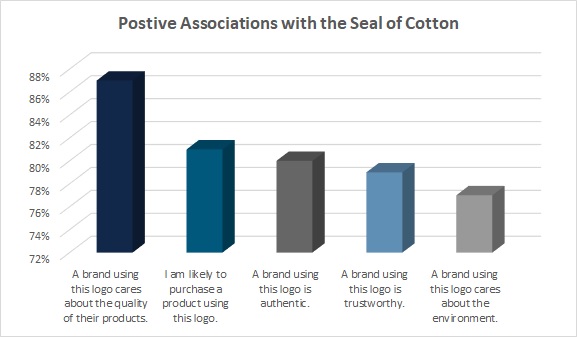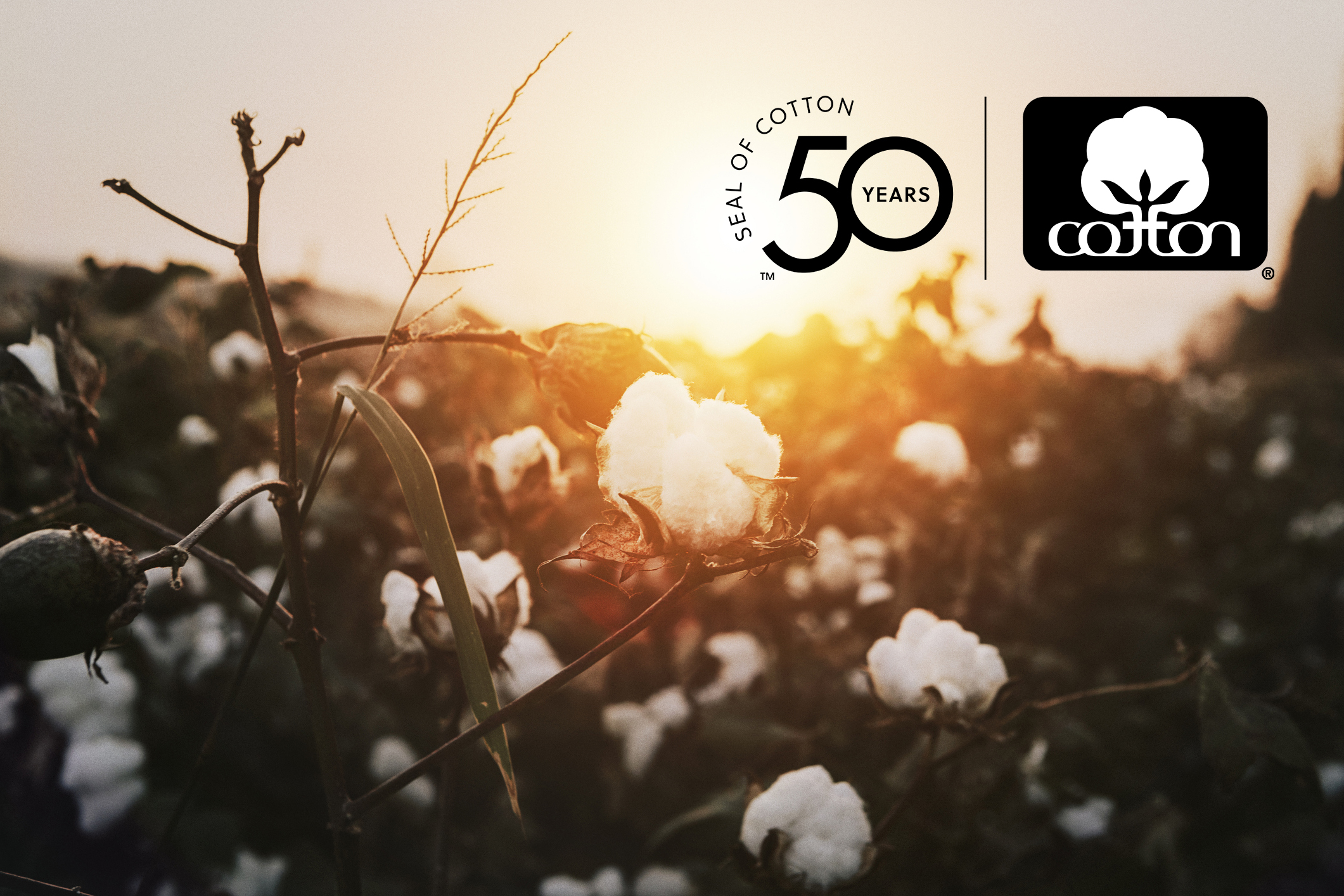As World Cotton Day took place October 7, it’s an opportune time for brands and designers to note the celebration of another cotton event: the 50th anniversary of the Seal of Cotton.
World Cotton Day is meant to both honor the natural fiber as well as show its enduring positive impact. Stakeholders from around the world came together to speak about the advantages of cotton, from its qualities as a natural fiber to the benefits it brings to people through its production. Topics included sustainability, women in cotton, and brand and retailer partnerships.
Meanwhile, the Seal of Cotton, which was introduced in 1973, is being celebrated as a globally recognized symbol associated with fashion, durability, quality, comfort, trust, and sustainability. Brands and designers should note the Seal of Cotton is a consumer influencer as well as a highly effective sales builder. More than 4 out of 5 consumers say a brand using the Seal of Cotton is concerned about quality (84 percent), “one I would be likely to purchase” (81 percent), authentic (80 percent), trustworthy (79 percent) and they care about the environment (77 percent), according to Cotton Incorporated’s 2023 Seal of Cotton Survey.
You have to be where consumers are, and you can see just from 2016 to 2023 the increase in awareness. And it’s not just sustainability because of our logo, but cotton in general in the marketplace. People have heard about microplastics and other things that have affected this knowledge.
Kim Kitchings, Senior Vice President of Consumer Marketing, Cotton Incorporated
“That’s important, that says a lot,” said Cotton Incorporated’s Kim Kitchings, senior vice president of consumer marketing, during a recent presentation at the company’s North Carolina headquarters. “This is recent research we’ve done that continues to show the Seal helps brands with their cotton business.”
Amy Williams, CEO of Citizens of Humanity Group, Citizens of Humanity, AGOLDE and Goldsign, says for more than 50 years, the Cotton Incorporated Seal of Cotton has been a signal of superior quality that is recognized around the world.
“We congratulate Cotton Incorporated on this milestone anniversary, and importantly, on their commitment to sustainable practices within the cotton industry for the next 50 years, and beyond,” Williams says. “As consumers around the world pay additional attention to sustainability, recycling, durability and versatile products, the Cotton Incorporated Seal will be even more important and covetable.”
Research backs this up, as an increasing majority of consumers have come to associate the Seal of Cotton with the characteristic of being “sustainable,” rising significantly from 59 percent in 2016 to 77 percent in 2020, and then again to 82 percent in 2023, according to Cotton Incorporated’s 2023 Seal of Cotton Consumer Research.
Further, cotton dominates most textile perceptions as the majority of consumers say the Seal of Cotton best represents attributes like “natural” (90 percent, up from 86 percent), “safe” (85 percent, up from 80 percent), “sustainable” (82 percent, up from 77 percent), and trusted (81 percent, up from 77 percent), according to the 2023 Seal of Cotton Consumer Research.
Kitchings says consumers just didn’t care as much about sustainability seven or eight years ago.
“Today is a much better time to give these messages,” Kitchings said. “You have to be where consumers are, and you can see just from 2016 to 2023 the increase in awareness. And it’s not just sustainability because of our logo, but cotton in general in the marketplace. People have heard about microplastics and other things that have affected this knowledge.”
Unlike synthetic, petroleum-based textiles like polyester, nylon and acrylic, which produce microplastic pollution and can take hundreds of years to decompose, cotton biodegrades quickly, something the International Cotton Advisory Committee (ICAC) likes to point out for World Cotton Day. The ICAC calls cotton “a natural fiber like no other,” one of the reasons being that its use decreases the number of plastics entering the planet’s waterways and helps to keep oceans clean.
Cotton’s sustainability factor is just one of the reasons the official theme for World Cotton Day is, “Cotton for Good.” Since cotton is made of cellulose, an organic compound that is the basis of plant cell walls and vegetable fibers, it biodegrades relatively quickly. This is the case in both soil and water. This quick and natural decomposition is vital, considering that every year, U.S. consumers alone discard more than 34 billion pounds of used textiles, according to a study from Boston University School of Public Health, and 66 percent of it winds up in landfills.
Unfortunately, more than two-thirds of all apparel (69 percent) is made of synthetic, petroleum-based fibers and more than half of that is polyester. When the tiny microfiber particles from synthetic clothing lands on the ground or in the water, it is consumed by both aquatic and land animals, working its way up the food chain. Of course, that means it reaches us humans. And a study in the Journal of Hazardous Materials found that people on average may ingest from 0.1-to-5 grams of microplastics every week. For reference purposes, a plastic credit card weighs about 5 grams. Since its initial publication, an author of the study has stated it’s possible there are people in the world who could be consuming an even higher number of particles.
“Additional studies that have detected microplastics in additional food and beverage groups, which changes the dataset and thus potentially changes the estimated global average rate of microplastics ingested,” said Kala Senathirajah, a co-author of the study. “The findings could be a gross underestimation of the amount of microplastics ingested for some people.”
Incredibly, scientists estimate that if something doesn’t change, our oceans will carry more plastic than fish (by weight) by 2050.
But it’s not just the land and water that are affected by synthetic clothes. Polyester production has 50 percent higher greenhouse gas (GHG) emission than cotton, according to a study published in the journal One Earth. And an article from Action for the Climate Emergency points out that more than half of all apparel (57 percent) ends up in landfills every year. As the apparel sits and degrades, it releases methane — “a potent greenhouse gas that is 28 times more powerful than carbon dioxide.” Once landfills reach capacity, the trash is incinerated, releasing more GHG into the atmosphere.
But cotton can be a kind of hero in this landscape. In both plant and the textile forms, cotton can help the climate impacts of clothes made from petroleum. The cotton plant captures carbon dioxide through photosynthesis, storing it in fiber, plant stalks and roots in the soil. The carbon captured on an acre of land is similar to the emissions from burning 657 gallons of gasoline – or 14,500 miles driven in an average gas-powered vehicle[1]. And there’s more: the carbon capture can continue in consumers’ closets, as cotton holds CO2 in fabric. For example, one pair of jeans, on average, can sequester 2.5 pounds of CO2.[2]
So now consider that more than 8 in 10 consumers (83 percent) consider cotton safe for the environment, according to the Cotton Council International and Cotton Incorporated’s 2023 Global Sustainability Study. This compares to 43 percent for rayon, 42 percent for polyester, and 42 percent for nylon.
This actually presents an opportunity for brands to meet consumer desire for sustainable, natural fibers by using cotton in their collections — and identifying it with the Seal of Cotton. That’s because fully 90 percent of consumers say the Seal of Cotton trademark helps them identify a product as containing cotton, according to the 2023 Seal of Cotton Consumer Research. And 82 percent say the Seal makes them feel they can rely on the product/brand associated with it. Another 81 percent say a brand that uses the Seal is helping them make an informed buying decision. And nearly three-fourths of shoppers (73 percent) say the Seal of Cotton makes their shopping experience easier.

Brands looking to use the Seal of Cotton on their products need only follow a handful of licensing steps. There are no fees or royalties involved – just the use of cotton in qualifying products.
Over the years, most consumers (67 percent) have learned about the Seal of Cotton on an actual product or its tag, according to the 2023 Seal of Cotton Consumer Research. Another 37 percent learned of it through store signage, followed by TV commercials (32 percent), retailer e-content (27 percent) social media (24 percent), and fashion sites/magazines (21 percent).
Aéropostale is another brand that has made use of the Seal, and plans to continue doing so, according to Michael DeLellis, executive vice president of marketing.
“As a leading Gen Z retailer of comfortable, casual clothing, cotton is an integral part of Aéropostale’s success,” DeLellis says. “Over the past 50 years, the Seal of Cotton has been a symbol of premium quality and durability, which has set the industry standard high and continues to inspire us. We look forward to the next 50 years of the logo we all know and love.”
[1] United States Environmental Protection Agency (2022). Greenhouse Gas Equivalencies Calculator. https://www.epa.gov/energy/greenhouse-gas-equivalencies-calculator
[2] Calculated based on these assumptions using a cotton carbon formula: 1. Cotton is approximately 95% cellulose 2. Cellulose is 44% carbon (based on the molecular formula for cellulose) 3. Every unit of carbon removed from the atmosphere represents 3.667 units of C02e removed (based on the molecular formula of carbon dioxide)
